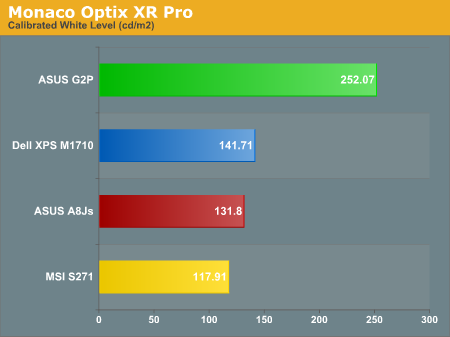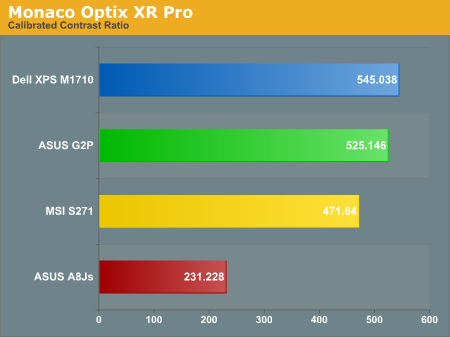Laptop LCD Roundup: Road Warriors Deserve Better
by Jarred Walton on May 22, 2007 5:00 AM EST- Posted in
- Displays
Brightness and Contrast Ratio
For these tests, we depend on the hardware colorimeter and software to help calibrate and measure the results from the displays. As previously stated, we use a Monaco Optix XR (DTP-94) colorimeter and Monaco Optix XR Pro software. On desktop displays we normally do some basic calibration to try and select an optimal brightness level, and we also look at the maximum and minimum brightness available. At least for the laptops we've seen so far, we really see no purpose in reducing the maximum brightness level except when running off of batteries. The ASUS G2P might be bright enough that that's an option, but the other three laptops already feel rather dim to begin with.



Objective testing confirms our impression that the ASUS G2P is easily the brightest display out of these laptops. The black levels may not be as dark as some people would like, but the net result is that you get a nice bright picture with a good contrast ratio. The ASUS A8Js goes the other route, offering mediocre whites and the worst blacks out of any of the laptops. This results in a very low 231:1 contrast ratio. The Dell and MSI laptops are similar in that both have dark blacks but only moderate whites. While this ends up giving the Dell XPS M1710 the highest contrast ratio, we definitely prefer the overall experience of using the G2P display.
For these tests, we depend on the hardware colorimeter and software to help calibrate and measure the results from the displays. As previously stated, we use a Monaco Optix XR (DTP-94) colorimeter and Monaco Optix XR Pro software. On desktop displays we normally do some basic calibration to try and select an optimal brightness level, and we also look at the maximum and minimum brightness available. At least for the laptops we've seen so far, we really see no purpose in reducing the maximum brightness level except when running off of batteries. The ASUS G2P might be bright enough that that's an option, but the other three laptops already feel rather dim to begin with.



Objective testing confirms our impression that the ASUS G2P is easily the brightest display out of these laptops. The black levels may not be as dark as some people would like, but the net result is that you get a nice bright picture with a good contrast ratio. The ASUS A8Js goes the other route, offering mediocre whites and the worst blacks out of any of the laptops. This results in a very low 231:1 contrast ratio. The Dell and MSI laptops are similar in that both have dark blacks but only moderate whites. While this ends up giving the Dell XPS M1710 the highest contrast ratio, we definitely prefer the overall experience of using the G2P display.










55 Comments
View All Comments
koljit singh - Saturday, August 9, 2008 - link
hii was confused in different manufacturers making same size lcds and which one fit which ones ?
i would like to import them but the model no are so huge it seems difficult to import all of them
is there any way to find out which ones fit which ones like compatibility chart would be great help
thanks
koljit
Oscarine - Wednesday, May 23, 2007 - link
Just a point of note that probably holds true for all the laptop manufacturers (especially Dell). Although the basic technology process for the displays I'm sure is the same, the quality of the sourced display even in the same model can vary wildly. When purchasing a dell with a WUXGA+ Res screen you could be recieving any number of manufacturers displays, fro Phillips, LG, Samsung, etc, and even among those manufacturers numerous different versions of the same panel. Case in point I owned a Dell 9300, with a samsung wuxga+ screen, it had poor contrast, miserable colors, and horrible light bleeding. Whereas my wife's 9300 had LG unit that had much better contrast, richer but less accurate color, and much less light bleed. All of this within the same model, at the same time period. So just like all the other components from DVD, HDD, even keyboards and whatnot are sourced from multiple manufacturers so are the displays, and some are significantly better than others in performance.JarredWalton - Wednesday, May 23, 2007 - link
Yeah... which really sucks but unfortunately we can't do much about it other than point out the fact. I will try to determine the panel manufacturers on the various laptops and update the table to reflect this information.lazybum131 - Tuesday, May 29, 2007 - link
Just a note about the updated table with the panel vendors, most likely the Seiko Epson panel reported for the M1710 is actually a Samsung panel. I just replaced a Samsung panel with a LG-Philips on my Latitude D620 (you may have heard about the screen complaints), where Astra reported the Samsung as a Seiko Epson SEC4457.Wesleyrpg - Wednesday, May 23, 2007 - link
hey there, great and infomative article.Any ideas who the manufacturer is of the panels in each laptop? I'm curious about the G2P, and apparently the A8JS has two different manufacturers of the panel used in it depending on the country you are based in.
I'm using a fujistu lifebook n6220, its got a Samsung 17inch panel, 1440 x 900, and a beautiful display, i wonder if its the same panel as the G2P???
austonia - Wednesday, May 23, 2007 - link
The quality of the display (viewing angles, brightness, contrast) is very high on my priority list when buying a notebook, yet few of them come with a decent display and few sites/reviewers focus on it. I hope Anandtech will follow up on this idea with a wider range of notebooks, when they can.jmvillafana - Tuesday, May 22, 2007 - link
This is a great topic with too few attention. As IT head for a large corporation I used to have Dell as standard for Laptops I used to be glad with response from the total user experience. When switching some 50 users from ispiron 8600 provided in 2004 to a Latitude D820 in late 2006, we had very bad comments. Better speed, better resolution, but the display brightness and clarity was really difficult in users eyes. When looking around for options of other brands, we found similar trends in other brands. Toshiba´s looked better than Dell´s still were not as good as their own laptops from three years before. It seems that most brands have looked for this area as a cut cutting opportunity. The problem is that we could not get better displays even as options for additional cost. The company that grabs this as a marketing opportunity has a good chance of making good money.figuerc - Tuesday, May 22, 2007 - link
Agreed - my old Toshiba (Celeron 400) has a better screen then my newer one (P4 2.8 ghz - not that new). Some of the newer dells and gateways are just terrible on the eyes.Theguynextdoor - Tuesday, May 22, 2007 - link
This little laptop has the Xbrite screen with an LED bulb. Does anyone know if this will be tested anytime soon?JarredWalton - Tuesday, May 22, 2007 - link
If Sony deems to send us one, we will happily test it. We don't have any contacts at Sony right now, unfortunately, so the best we can do is ask and hope for a response. If any of you have an inside track at Sony, tell them to contact me via email.